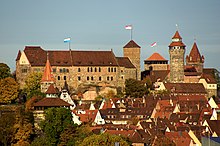You can help expand this article with text translated from the corresponding article in German. (August 2010) Click [show] for important translation instructions.
|
Burgraviate of Nuremberg Burggrafschaft Nürnberg (German) | |||||||||||||
|---|---|---|---|---|---|---|---|---|---|---|---|---|---|
| 1105–1440 | |||||||||||||
Flag under the Raabs
Coat of arms under
the Hohenzollern | |||||||||||||
| Status | County of the Holy Roman Empire | ||||||||||||
| Capital | Nuremberg | ||||||||||||
| Religion | Roman Catholic | ||||||||||||
| Government | County | ||||||||||||
| Historical era | Middle Ages | ||||||||||||
• First documentary mention | 1050 | ||||||||||||
| 1105 | |||||||||||||
• City administration transferred | 1173/74 | ||||||||||||
| 1191 | |||||||||||||
• Großer Freiheitsbrief granted to city | 1219 | ||||||||||||
• Raised to princely status | 1363 | ||||||||||||
1427 1440 | |||||||||||||
1440 | |||||||||||||
| |||||||||||||
| Today part of | Germany | ||||||||||||




The Burgraviate of Nuremberg (German: Burggrafschaft Nürnberg) was a state of the Holy Roman Empire from the early 12th to the late 15th centuries. As a burgraviate, it was a county seated in the town of Nuremberg; almost two centuries passed before the burgraviate lost power over the city, which became independent from 1219. Eventually, the burgraviate was partitioned to form Brandenburg-Ansbach and Brandenburg-Bayreuth.

